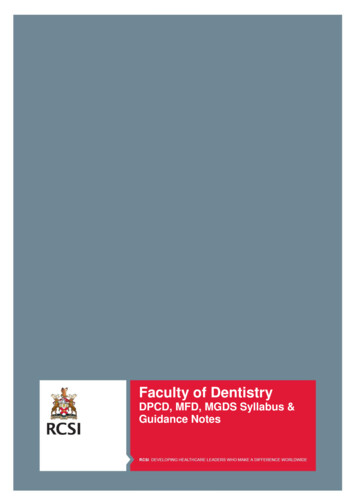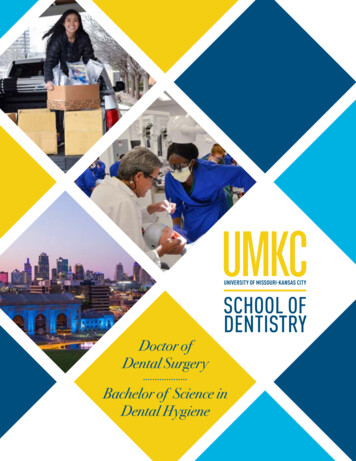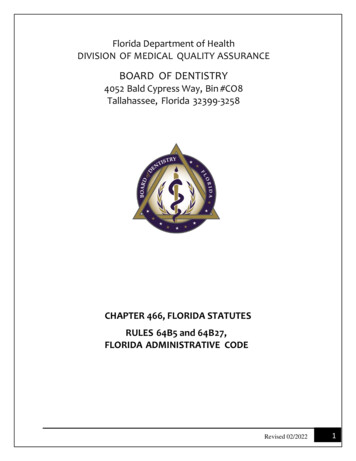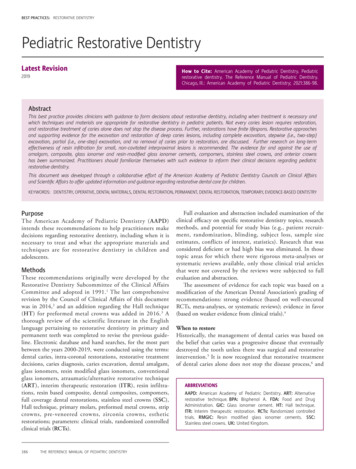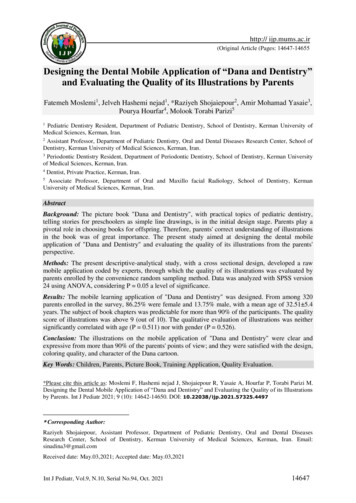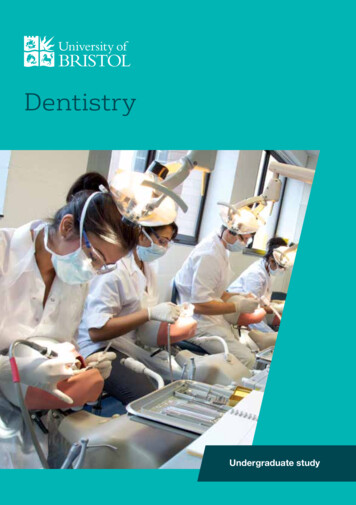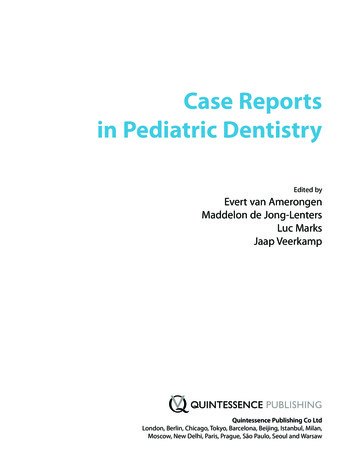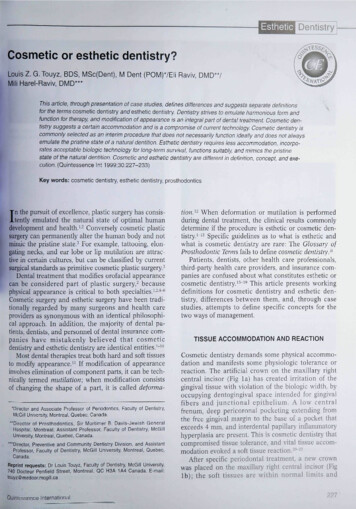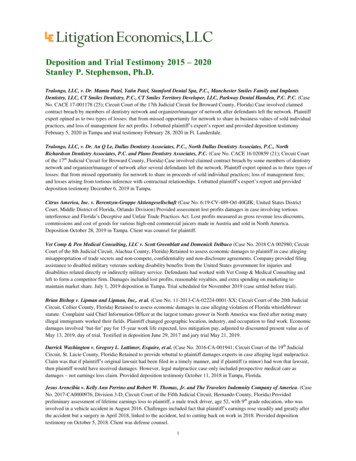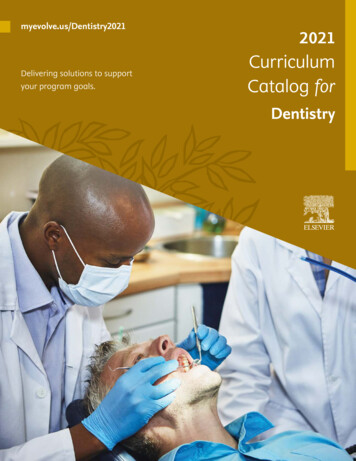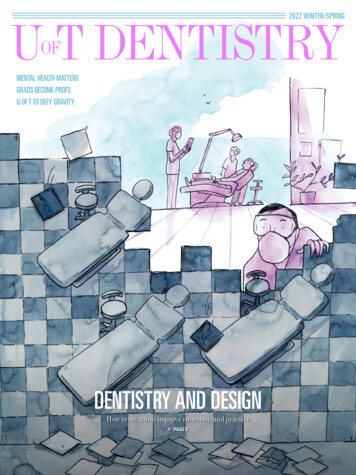
Transcription
2022 WINTER/SPRINGMENTAL HEALTH MATTERSGRADS BECOME PROFSU OF T TO DEFY GRAVITYDENTISTRY AND DESIGNHow renovations improve education and practice PAGE 8
2022 WINTER/SPRING348FEATURE STORYUP FRONTTHE DESIGN ISSUE812182022Photo: Courtesy of Montgomery Sisam ArchitectsMESSAGE FROM THE DEAN THE LEARNING ENVIRONMENTThe educational value of upgradesat dentistry schools DESIGN THAT CARESDentists focus on office aesthetics,not just function HONOURING DEAN HAAS’S LEGACYThe Faculty reflects on a decadeof leadership FALL 2021 GRADUATIONFour graduates pursue careersin academia ALUMNI OF INFLUENCECelebrating the accomplishmentsof Marie Dagenais, Victor Moncarzand Frank Stechey26 DEFY GRAVITY31 WE REMEMBERWho we serve; U of T’s newfundraising campaignRendering of the proposed patient reception area at 101 Elm St.EDITORIAL TEAMADVANCEMENT OFFICE CONTACTSEditor-in-Chief: RACHEL BOUTETSELINA ESTEVESDirector of 6) 580-2802JULIA AL AKAILADevelopment Officerjulia.alakaila@dentistry.utoronto.ca(416) 864-8202MARSHA MALCOLMAdvancement 6) 864-8200ROSHAAN HAJIRAAlumni Engagement Officerroshaan.hajira@dentistry.utoronto.ca(416) 864-8203Managing Editor/Writer:DIANE PETERSContributing Editors:SELINA ESTEVES, MARSHAMALCOLM, ALEX MLYNEKArt Direction & Production:FRESH ART & DESIGN INC.Cover Illustration:GRAHAM ROUMIEU2 U N IV E RS ITY O F TORONTO FACULTY OF DENTISTRYEDITORIAL ENQUIRIES AND SUBMISSIONSRACHEL BOUTETUniversity of TorontoFaculty of Dentistry124 Edward Street, Room 303Toronto, ON M5G 1G6(416) 864-8333rachel.halpern@dentistry.utoronto.caU of T Dentistry is publishedtwice yearly by the Universityof Toronto Faculty of Dentistry.Materials published do notnecessarily represent theofficial position of the Facultyof Dentistry or the Universityof Toronto.VISIT US ONLINE AT: WWW.DENTISTRY.UTORONTO.CA
MESSAGEFROM THEDEANBUILDING THE FUTURE OF DENTISTRYThis issue of U of T Dentistry magazinefocuses on the buildings that housedentistry’s teaching, research andpatient care. Our historic buildingrequires upgrades in order to betterserve our entire community. One ofour feature stories will look at theimpact renovated spaces have onour students, faculty and patients.We have made great progress withupdates to our main building at 124Edward St., including our research labs,the latest renovation to our auditorium andthe addition of a central medical devicereprocessing facility. After several monthsof operations, we have also seen how ournew satellite clinic at 777 Bay St. hasallowed a significant increase in capacityfor our DDS students’ clinical training.This clinic will be invaluable as a swing space as we look forward to upgrading our simulation lab and Clinic 2.As we continue with our efforts to enhance our spaces,we have launched a new fundraising initiative as part of theUniversity’s Defy Gravity campaign. The success of theBoundless campaign has put U of T in the right direction forthis next chapter of excellence.In this magazine, you will also read about the importanceof clinic design, highlighting several members of our alumnicommunity in their private practices. The physical space in adental office can impact many aspects of the practice, includingpatient comfort level and staff efficiency. Design has becomean important factor in the way many dentists are setting uptheir offices for a better experience.Finally, I would like to say thank you toall of you, the valued members of ouralumni community. It has been a truehonour and privilege to serve as dean forthe past 10 years. While the last twoof those years involved challenging circumstances, our community showedtremendous resiliency and our Facultycontinued to achieve excellence in research,education and patient care. I am humbledto have been part of this experience and I am grateful to alsobe a member of the alumni community. I look forward toseeing you in person at events in the near future.It has been a truehonour andprivilege to serveas dean for thepast 10 yearsDEAN DANIEL HAAS 7T9, 8T8 PHD2022 W IN TE R/S P RIN G 3
Photo: Courtesy of the Bozec LabUP FRONTA microscopic view of damaged tooth enamelTEETH WHITENING DAMAGEAstudy published by U of T Dentistry associate penetration of the whitening agent inside the tooth, whichprofessor Laurent Bozec shows teeth-whit- can lead to an increase in dental-pulp cell mortality. The teamening products may harm dental cells. tested this using an in-house dentine perfusion chamber andInternational visiting PhD student Ola Redha found that when exposed to more than the recommendedfrom University College London was a dose, dental pulp cells did not survive.key contributor to research that“Many home tooth-whitening products haveassessed the dental cell damagesuch a high concentration of CP gel and yet littlecaused by the use of carbamide peroxide (CP)is known about what it does to the inside of ourteeth-whitening treatments. The Faculty’s proteeth,” says Bozec. “We believe this is the firstfessor Boris Hinz and DDS4 student Sabrinastudy of its kind to show the toxic effects of usingreduction toa tooth-whitening agent.”Nguyen also supported the study.the enamelUsing an in-vitro dentin perfusion assay model,The study shows the need for a compromiseprotein contentBozec and the team showed that an application ofbetween the concentrations of peroxide used, expoby cp gelCP gel reduces the enamel protein content of teethsure time, desired patient outcomes and sideapplicationby up to 50 per cent. This loss results in a greatereffects experienced.4 U N IV E RS ITY O F TORONTO FACULTY OF DENTISTRY50%
Photo: Ann SandersonTHE BIOLOGY OF TMDCOURSEDESIGNGOES MICROTTMD causes debilitating painTemporomandibular disorder (TMD) affects eight to 12 per cent ofCanadians. “TMD is a huge cause of orofacial pain, but it’s understudied,” says Massieh Moayedi, assistant professor at the Faculty.Last fall, the Canadian Institutes of Health Research awardedMoayedi and assistant professor Iacopo Cioffi 830,000 overfive years — in addition to an initial 100,000 — to identify a biologicalsignature of TMD by looking at muscles and nerves in a multi-centretrial of about 300 people.Current treatment approaches are not effective — more than 30per cent of people with TMD are still in pain five years after diagnosis.As well, we know little about trigeminal neuropathic pain (TNP).Dentists and physicians diagnose these disorders by palpating facialmuscles and asking for reports of pain and its impact on function. “It’svery subjective,” says Cioffi.With more information, doctors could categorize these conditionsfrom mild to severe, plus match treatments to biological causes.Currently, most people with facial pain get a treatment approach thatstarts conservatively and ramps up to seewhat works for them.Follow-up research will assess whichtreatments most effectively impact specific biomarkers, plus look into the originsof facial pain. Says Moayedi: “It opens thedoor to how we can prevent it.”TMD is a hugecause of orofacialpain, but it’sunderstudiedhe Faculty of Dentistry is offeringa microcredential to help coursedirectors improve their coursedesign skills and put them into practice.Jack Gerrow 7T9, adjunct professorat the Faculty, spearheaded the new,year-long program.The goal of the microcredential is to“improve participant knowledge oflearning pedagogy with respect to coursedesign and to enable participants toimplement this knowledge into actionable change into their curricula.”Participants are attending workshopsand completing assignments that willserve as their course outline and evaluation system for the following year.BOARDLEADERSHIPGet involved with the Dentistry alumniboard. See the new application form onthe website to see how you may beable to participate!uoft.me/dentistry-alumni-board2022 W IN TE R/S P RIN G 5
UP FRONTPRIORITIZINGMENTAL HEALTHMEASURINGCOVID-19IN DENTISTSJoel RosenbloomThe Faculty of Dentistry is putting a greater emphasis on mentalhealth education. This includes a new third-year course calledPsychiatry and Dentistry, plus clinical rotations at the Centrefor Addiction and Mental Health (CAMH). DDS3 students canchoose to do a one-week clinical rotation at CAMH and everyfourth-year student is required to attend for one day.“One in five people suffer from mental illness,” explains JoelRosenbloom, assistant professor, teaching stream, who spends two daysa week as a staff dentist at CAMH. “We have to equip our students todeal with this because if we ignore it, we do so at the expense of themand our patients.”Rosenbloom is the director and a lecturer for the third-year courseand helps run lunch-and-learn sessions at the Faculty on mental health.“The defining illness of this generation is no longer heart diseaseor cancer — it’s mental illness,” says Rosenbloom. “The moreprofessors and dentists set the tonethat it’s OK to confide in othersabout what you’re going through,the more we create an environmentwhere we can welcome open andhonest communication to supporteach other institutionally and ashuman beings.”The defining illnessof this generation isno longer heartdisease or cancer —it’s mental illness6 U N IV E RS ITY O F TORONTO FACULTY OF DENTISTRYPhoto: Jeff ComberEarly on, many assumed COVID-19would spread dangerously indentistry. But a study publishedin the Journal of the American DentalAssociation, which looked at 644licensed dentists across Canada oversix months, showed infection ratesamong Canadian dentists similar tothat of the general population.The collaborative study was led byMcGill University assistant professorSreenath Madathil. U of T Dentistryprofessors Carlos Quiñonez 0T9 PhDand Michael Glogauer 9T3, 9T9 DipPerio, 9T9 PhD were also co-authors.“This study further shows the safetyof dental care,” says Glogauer. “Theprofession’s ability to adapt quickly isshown in this study and the data showswe remain a very safe profession.”STAY INTOUCHStay connected with what’s happeningat the Faculty and what your fellowalumni and friends are doing in thecommunity. Update your contact info at:dentistry.utoronto.ca/alumni
ADVOCATING FOR ANEGLECTED OROFACIAL DISEASEStudents at the Faculty of Dentistry are advocating formore awareness and action to combat noma, apreventable disease that is affecting young childrenin impoverished communities. Noma occurs whenbacteria and microbes quickly destroy facial bonesand tissues, leading tosevere facial disfigurements and often death.The Faculty’s NomaAction Group (NAG)was started in 2020 byJoel Rosenbloom, assistant professor, teachingstream, and is run byDDS4 students VivianAn and Jacob Thomas.If the project issuccessful, thenevery single dentalstudent in Canadawill graduate witha sound knowledgeabout nomaThe goal of NAG is to raise public awareness and encouragethe World Health Organization to include noma on its listof Neglected Tropical Diseases.NAG has hosted several events, including one inNovember 2021 featuring Fidel Strub, a survivor of thedisease. NAG’s future goals include presenting One Hourfor Noma, a lecture, at all dental schools in Canada to helpspread the word about the disease and inspire people to domore about it.According to Rosenbloom, “If the One Hour for Nomaproject is successful, then every single dental student inCanada will graduate with a sound knowledge about noma.Given that noma is not well known among Canadiandentists and that awareness raising is critical, this wouldbe an amazing step forward in the campaign to have thisdisease eradicated.”2022 W IN TE R/S P RIN G 7
COVER STORYTHE BEAUTYOF LEARNINGHow upgrades at faculties of dentistry impactlearning, research, patient care and perceptionsBY DIANE PETERSILLUSTRATION BY GRAHAM ROUMIEU
Professor Siew-Ging Gong’s glassedin office on the fifth floor of theFaculty of Dentistry’s 124 EdwardSt. building catches light from a rowof windows that runs along the opposite wall. In turn, those windowsmore directly brighten open-conceptwork benches used by research associates, PhD students and people like Gong’s new postdoctoral fellow, who just arrived from India.She used to have an office with a window, but this is amore egalitarian use of light. Plus, everything is new andput together in soothing shades of grey and white withblond wood. Gong isn’t sure if she’s working differentlyor more efficiently in this upgraded environment, but shelikes being surrounded by well-thought-out design. “It’snice to be in a nice space,” she says.The 21.5-million renovation that made these brightwork stations possible was completed in 2018, and encompassed the building’s fourth floor as well, giving each floora new kitchen nook and shared lounge spaces, plus techenabled meeting rooms and classrooms. “You feel betterbeing here,” says Gong. “There’s more light; it feels clean,”she says of the upgrades that also transformed individuallabs into large, shared spaces, with the addition of numerous specialized labs, too.While those who work, research and learn on the toptwo floors of the dentistry building enjoy their fresh surroundings, much of 124 Edward St. still requires upgrades.The building dates back to 1959, and until recently, its lastmajor renovation had taken place in the 1980s.The Faculty is fundraising to renovate Lab 4, the preclinical simulation lab, as early as 2022, and follow that upwith work on Clinic 2. These upgrades will complementthe recent work on the main auditorium and a centralmedical device reprocessing facility.With a new satellite clinic in operation at 777 Bay St.,the Faculty of Dentistry is ready to address the displacement of clinical operations caused by a temporary closureof Clinic 2. Meanwhile, the look and functionality of thenew clinic, plus the successful remodelling of the upperfloors of the main building, serve as reminders of whatstate-of-the-art spaces offer.“There’s nothing wrong with 124 Edward St.,” saysSteven Brown 8T0, a Toronto-based dentist who has been aclinical instructor at the Faculty since 2016. “It works. It’slivable. But it’s not as nice as we’d like it to be. It’s nice tosee things are being updated.”Adam Trotter, senior planner with University Planning,Design & Construction at U of T, says the work done atuniversities today balances practicalities and regulations— along with approaches to make buildings less carbonintensive — with the needs of those using the space. “Thebiggest part is making sure that the building they end upwith is as ideal as possible to support the teaching, learningand research that happens.”DESIGN IN DENTAL EDUCATIONMost faculties of dentistry in Canada date back a half orfull century and are housed in buildings from bygone eras.Hence, many of the 10 schools have been modernizing.That includes McGill University, which moved its clinic,teaching spaces, pre-clinical lab and administrative officesto a new location in 2014, investing 18 million. DalhousieUniversity opened a 50,000-square-foot, 28-million clinicin fall 2018 — it had last been renovated in the 1980s.2022 W IN TE R/S P RIN G 9
COVER STORYAt the University of Alberta, the 1922 building dentistryshares with pharmacy is undergoing a 149-million upgrade. Both Western University and the University of Saskatchewan plan to renovate their dentistry facilities soon.While universities upgrade all the time, dental schoolsface different complexities: no other group on campus hasto encompass research, didactic learning, simulation labs,diagnostic labs and patient-facing clinics, all under oneumbrella. “You’re literally running a dental hospital,” saysprofessor Chris McCulloch 7T6, 8T2 PhD. This both keepsthe dentistry building in the public eye and increases thecost of providing education.between students and instructors. Brown says he’s assignedto a single row in the clinic, so he works with the samestudents week after week. “When you see a student over andover again, you feel comfortable knowing what they need.”Practicalities aside, the new space is also just an aesthetically pleasing place to be. “It’s incredible. You can seethe whole of the city, it’s all windows, all glass. Everyonesays it but it really is like night and day; it’s daylight all thetime at 777,” says Brown.Jacob Thomas, a DDS4 student, appreciates being ableto learn in a fresh environment. “It’s so nice to be in theclinic. Everything’s so new,” he says.IMPACT ON LEARNINGDesign matters when it comes to teaching clinics andclassrooms. Some older clinical spaces were designed totreat patients in large numbers and were not focused onfacilitating instruction, particularly group teaching. “It’sreally hard to demonstrate for one student, let alone eightto 10 students,” says Jack Gerrow, an adjunct professor atU of T and former registrar of the National Dental Examining Board of Canada, who has taught at and consultedwith numerous dental schools. “Dentistry involves 3Dskills, so sometimes you have to show people,” he says.In tight spaces, you can have just one or two studentsobserve a procedure.Students, instructors and patients at the Faculty ofDentistry have been able to see how a more modern spaceworks in action at the new satellite clinic. The clinic hasbeen carefully designed for today’s clinical teaching experience, complete with enclosed operatories that allow forsightlines between instructors and students. Technology isfully integrated with easier access to the tools and equipment students and instructors need.Operations have dovetailed with the opening of theFaculty’s central medical device reprocessing facility, whichensures a standardized approach to sterilization. “Now thatall devices are distributed and collected on a cart system,it frees up critical space in the clinic,” says Larry Schnuck,vice-president and leader of the higher education team atKahler Slater, the U.S.-based firm that consulted on thefacilities component of the latest Faculty master plan. Thischange benefits all the clinics and will influence designchoices moving forward, too.At McGill, the team opted for a streamlined design. “Webuilt the clinic from the ground up with technology alreadyincorporated into it,” says Jeffrey Myers, who was clinicaldirector at the time of the move. “There’s no exposed wiring. And we designed the treatment rooms so they’re easyto clean and there’s limited storage space. Things are easierto keep track of and there’s no dust collectors.”The design of the Faculty’s satellite clinic allowed forstaff to organize operations to help strengthen relationshipsA CLASSROOM SHIFTNewly renovated classrooms feature multiple screens and tables and chairs on wheels, which creates the so-called flippedclassroom that supports student-centred learning. “We’restill trying to get people to realize that student-centred teaching is a lot more effective way of getting information across,”notes Gerrow. “The big lecture hall enables a method ofteaching that’s not as effective for novice learners.”Indeed, changes in both clinical and didactic environments in dental schools reflect emerging teaching values.“There’s been a shift in pedagogy through universities,and dentistry is a part of that,” says Trotter. “All these newrenovations we’ve done and are planning are keeping upwith these trends.”10 U N IV E RS IT Y O F TORONTO FACULTY OF DENTISTRYSUPPORTING RESEARCHThe open-concept labs on the research floors of the dentistry building were intended to maximize space — thewalls between small, individual labs eat up valuable squarefootage — and enable collaboration.McCulloch worked for most of his lengthy research career at the century-old FitzGerald Building in what he calls“rabbit runs.” Now that he spends his days in open labsand has an office with a glass door, and can have a coffeebreak or lunch in comfortable, shared settings, he’s gettingto know more of his colleagues.“Collaborations are easier,” he says. McCulloch hadnever met assistant professor Karina Carneiro before 2018,but thanks to running into her at work, they’ve landed fourgrants together. “That never would have happened withoutthis kind of space.”Modern labs come better equipped to deal with needsaround power and technology, but also infection control.And it’s not just the motion-activated sinks — althoughthose help. “The material of the new work surface is moreeasily cleaned and so much easier to maintain,” says labmanager and research associate Delphine Dufour. Shealso appreciates the bigger and brighter work space, whichmakes her work day more pleasant.In older spaces, labs and desks would be side by side,
Photo: Courtesy of Montgomery Sisam ArchitectsRendering of the Faculty’s proposed Clinic 2now they’re separate. “This change reflects a much higherstandard of biosafety and overall lab safety,” says McCulloch.And while enclosed labs may seem safer in the era ofCOVID-19, the larger, well-ventilated labs at 124 Edward St.have been safe to use during the pandemic. “Social distancing has been made vastly easier,” says McCulloch.The Faculty’s foresight in designing these new labsalso meant investing in core facilities to enable specializedresearch — even when the researchers did not yet havethe equipment for these labs. McCulloch’s own fibrosisresearch has recently yielded sizable infrastructure grantsto fill an imaging lab at the Faculty.MATTER OF PERCEPTIONThomas says the differences between the on-campusDDS clinic and the new location are subtle — after all,the quality of the care and level of hygiene is the same.“The patients are really happy to get to the new clinic.It’s subjectively a better experience.”And while the new clinic is equipped with enclosedoperatories to align with the latest infection control guidance, this layout also more closely resembles the usualdental visit experience. “It’s a change from a patient carestandpoint,” says Schnuck.For students, the new space mimics where they mightwork as a trained dentist. “It just feels like we’re closer tograduation. We’re more professional instead of in a studentenvironment,” says Thomas. Schnuck agrees: while not allstudents go on to work in private practice, learning in anenvironment that feels somewhat similar, plus is equippedwith the type of technology they’d see in regular dentalclinics, helps them transition into the profession.At labs, too, design changes have made the researchenvironment more congenial. “Social interactions did certainly change. Walking through lab space that is not oursand seeing members from other teams is very pleasant,”says Dufour, noting that you get more smiles and hellosnow than ever before.Designers involved in these kinds of projects aim tomake space better for everyone. “Our goal is to make it asinviting and welcoming as possible,” says Trotter. To thatend, for instance, work is being planned for 124 EdwardSt. that will take advantage of natural light and improvewayfinding for visitors and new students. “We’re going tomake the environment more modern, brighter and fresher.I think that goes a long way,” he says.These perceived differences matter to staff, faculty andalumni, who want to be proud of their school. “I’ve seenit where something has been added to a school or there’sbeen a new renovation, and you can see the instructors andthe students bringing their friends and colleagues in andsaying, ‘Wow, look at this,’” says Gerrow.Trotter agrees that when universities present newspaces to the public, everyone is curious. “The renewal of aplace tends to bring a renewed interest in the public eye tothe department or faculty,” he says.McCulloch thinks investing in physical space bettersupports teams in achieving excellence and meeting expectations. “We’re part of U of T,” he says. “We’re competinginternationally. We’re not doing our job within the Universityif we’re not staying in step with the larger mandate ofbeing part of a world-class research university.”2022 W IN TE R/S P RIN G 11
COVERFEATURESTORYSTORYSTYLEAT THEDENTALOFFICEDentists have always focused on theaesthetics of the mouth, not the room.But now, they’re becoming interestedin and are investing in clinic design.Looking good boosts their businessesand better supports patients and staffBY MARK WITTENPHOTO OOMPH DESIGN12 U N IV E RS ITY O F TORONTO FACULTY OF DENTISTRY
Surgery room at Chagger Dental
Photo: Courtesy of Mark LinCOVERFEATURESTORYSTORYThe modernized consult room at Mark Lin’s officeProsthodontist Mark Lin 1T0 MScProstho knew his practice hadoutgrown its cramped and somewhattired-looking space in north Toronto.The four treatment rooms, reception area and consultation room thatdoubled as his office no longer metthe needs of the team or patients.Lin wanted a functional separation between clinical andbusiness areas, along with more treatment rooms, moreoffice and reception space, and a well-positioned digital labto support a larger number of patients and the continuedgrowth of his specialty practice.“Some longtime patients commented that the highquality dentistry they received didn’t fit with the look of thebuilding. They were being honest, and I listened to theirfeedback,” says Lin. Instead of just setting aside a basicbudget and giving a builder general instructions, he madethe choice to prioritize the look and feel of the clinic. Linworked closely with an interior designer and project teamto renovate, redesign and expand his clinic in 2018.The effort was worth it: his clinic is now sleek, elegantand understated in monochromatic whites, greys andblacks. “I wanted a contemporary, clean look that isn’t sterile, but welcoming for my staff and patients.” He likes thathis renovated office still looks like a healthcare facility.While dentists are very much medical professionals,they’re also often business owners. Increasingly, generaldentists and specialists like Lin are learning about designand what it can do for their businesses and their patients.“Dental offices used to be designed based on cost and14 U N IV E RS ITY O F TORONTO FACULTY OF DENTISTRYwhat was easiest for the contractor, and dentists rarelyused an architect or interior designer. Now I see a lot ofdesign-conscious dental clients,” says Ancaster-basedOomph Design principal Ian Graham, who has designedmore than 70 dental clinics in Ontario. He’s seen a hugeupsurge of interest in office design in the dental professionover the past decade. “They are looking locally and globallyfor ideas, but also want to make their office look differentthan everyone else’s.”It’s most often urban dentists who are looking to designto help set themselves apart. “In the larger cities, such asToronto, where there is a lot of competition in dentistry,and design services are readily available, dentists are usingarchitects and designers more often,” says James Posluns9T1, 9T8 Dip Ortho, assistant professor and director ofclinical affairs with the Faculty.But investing in design is only partly about competition.Both patients and staff are better supported by a carefullyput together clinical environment. Looking good in dentistry — and in dental offices — isn’t superficial at all.BRANDING THE BUSINESSDesign is a powerful branding tool for establishing andpromoting a single dental practice, or group of clinics, inan increasingly competitive market. “I approach a dentaloffice like a retail environment, with integrated graphicsand signage that help bring the brand to life. A branded environment should be everything that the brand representsfrom the entry to the exit experience. The goal is to make avisit to the dental office a positive and memorable experience for the patient,” says Graham.
Photo: Maxime BrouilletThe reception desk at Go Orthodontistes in MontrealFor Lin, branding through design is about making surethe type of care offered is reflected in the environment.“You have to create your own brand and see things throughthe patient’s eyes. Patients have a perception when they seea specialist that the standard of care must be very high. Thevisual component is extremely important, and the physicalenvironment needs to match the quality of care,” says Lin.For some dentists, the design of their clinic reflectstheir professional personality. “The office is an expressionof who they are and how they work. It’s engaging and captivating for the designer because dentists often have distinctpersonalities and aspirations with specific wants for theirclinic to look special and unique,” says Toronto-basedarchitect and interior designer Tania Bortolotto.Graham has worked with numerous dentists in different clinical environments and helps his clients develop alook that reflects their unique offering. That’s ranged fromdesigning dental practices with multiple locations — suchas Chagger Dental and Toothworks Dental Clinics — aswell as distinctive-themed, single locations. For instance,Oomph’s strategy for Smile Studio Dental in RichmondHill aimed to please upscale clients with the look and feelof a sophisticated boutique hotel.WELCOMING PATIENTSThe new emphasis on design in dentistry puts patients —and how they feel during treatment — first. “When youcreate a warm, inviting environment, it helps patients fightoff their fear and pain, and a positive experience helpsbring them back to your office in the future,” says BobbyChagger 9T6, whose flagship Oakville clinic featuringbold, playful colours and glass-enclosed operatories set thetone for his successful expansion to a network of officesacross southern Ontario.The Faculty’s new, state-of-the-art satellite clinic at 777Bay St. illustrates how good design can make the functional requirement of enclosed operatories for infection controlaesthetically appealing. One side of each of the 41 spacious treatment rooms is glass with a sliding door to takeadvantage of natural light, and each of the four blocks of10 operatories is colour-coded in blue, orange, yellow andsilver. “The design had to be clean and simple, but we created interest by adding colo
dentistry.utoronto.ca (416) 864-8202 ROSHAAN HAJIRA Alumni Engagement Officer roshaan.hajira@FRESH ART & DESIGN INC. dentistry.utoronto.ca (416) 864-8203 MARSHA MALCOLM Advancement Coordinator marsha.malcolm@ dentistry.utoronto.ca (416) 864-8200 RACHEL BOUTET University of Toronto Faculty of Dentistry 124 Edward Street, Room 303 Toronto, ON M5G 1G6
